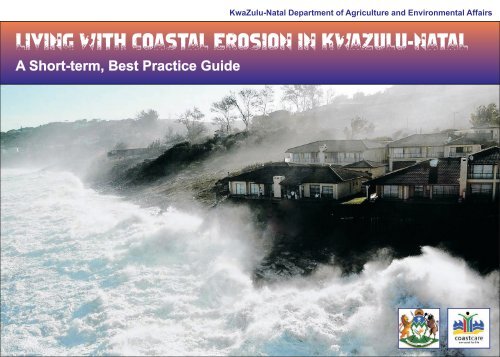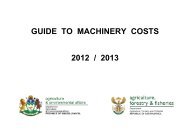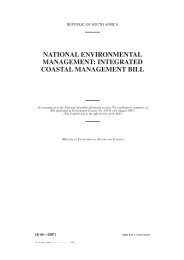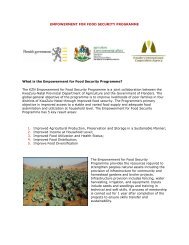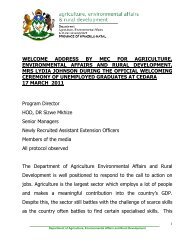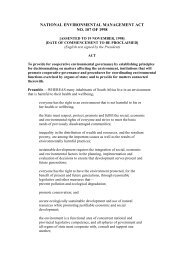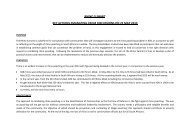living with coastal erosion in kwazulu-natal - Department of ...
living with coastal erosion in kwazulu-natal - Department of ...
living with coastal erosion in kwazulu-natal - Department of ...
You also want an ePaper? Increase the reach of your titles
YUMPU automatically turns print PDFs into web optimized ePapers that Google loves.
KwaZulu-Natal <strong>Department</strong> <strong>of</strong> Agriculture and Environmental Affairs<br />
LIVING WITH COASTAL EROSION IN KWAZULU-NATAL<br />
A Short-term, Best Practice Guide
Table <strong>of</strong> Contents<br />
Pr<strong>in</strong>ciples . . . . . . . . . . . . . . . . . . . . . . . . . . . . . . . 1<br />
Background . . . . . . . . . . . . . . . . . . . . . . . . . . . . . 2<br />
Coastal Erosion Risk <strong>in</strong> KwaZulu-Natal . . . . . . . 4<br />
Responses to Coastal Erosion. . . . . . . . . . . . . . 6<br />
A Short-term Response Strategy . . . . . . . . . . . . 8<br />
Roles and Responsibilities <strong>of</strong> Key Agencies . 11<br />
Environmental Authorizations Required . . . . . 12<br />
Acknowledgements . . . . . . . . . . . . . . . . . . . . . . 13<br />
Further Read<strong>in</strong>g . . . . . . . . . . . . . . . . . . . . . . . . . 13<br />
“Today's <strong>coastal</strong> development along <strong>with</strong> hurricane amnesia<br />
places modern man on a collision course <strong>with</strong> catastrophe if<br />
the lessons <strong>of</strong> history are ignored.”<br />
Max Mayfield, Director: National Hurricane Center, USA<br />
“It goes way beyond beach restoration issues. It really deals<br />
<strong>with</strong> look<strong>in</strong>g on a long-term basis how we allow development<br />
on our <strong>coastal</strong> areas.”<br />
Jeb Bush, 43rd Governor <strong>of</strong> Florida, USA<br />
North Beach Pier, Durban<br />
Front cover: T<strong>in</strong>ley Manor<br />
Back cover: Umkomaas<br />
LIVING WITH COASTAL EROSION IN KWAZULU-NATAL
Pr<strong>in</strong>ciples<br />
Liv<strong>in</strong>g <strong>with</strong> <strong>coastal</strong> <strong>erosion</strong> <strong>in</strong> KwaZulu-Natal<br />
requires that the follow<strong>in</strong>g pr<strong>in</strong>ciples are<br />
acknowledged:<br />
Cont<strong>in</strong>ued global warm<strong>in</strong>g will cause sea-level rise and <strong>in</strong>creased<br />
<strong>in</strong>tensity and frequency <strong>of</strong> <strong>coastal</strong> storms.<br />
Increased <strong>coastal</strong> <strong>erosion</strong> will lead to higher and cont<strong>in</strong>ued risk to<br />
human life and the natural and built environments.<br />
Best <strong>in</strong>ternational practice <strong>in</strong> the face <strong>of</strong> sea-level rise and chang<strong>in</strong>g<br />
<strong>coastal</strong> dynamics is a managed retreat away from the shorel<strong>in</strong>e.<br />
It is not <strong>in</strong>conceivable that KwaZulu-Natal's beaches will lose more<br />
sand as a result <strong>of</strong> natural processes.<br />
The severity <strong>of</strong> this loss will be dependant on co<strong>in</strong>cid<strong>in</strong>g phenomena<br />
such as storm events, equ<strong>in</strong>oxes and spr<strong>in</strong>g high-tides.<br />
Any construction too close to the beach <strong>in</strong>terferes <strong>with</strong> natural sand<br />
movement and may impede beach recovery after a serious storm event.<br />
Remov<strong>in</strong>g sand from beaches <strong>in</strong>creases the severity <strong>of</strong> <strong>erosion</strong>.<br />
Badly planned and <strong>in</strong>appropriate sea defences may cause further loss<br />
<strong>of</strong> sand, result<strong>in</strong>g <strong>in</strong> beach degradation on site and to beaches and<br />
properties further along the coast.<br />
Remov<strong>in</strong>g vegetation from dunes destabilises these protective sand<br />
barriers and reduces its function as natural sea defences.<br />
Salt Rock<br />
A SHORT-TERM, BEST PRACTICE GUIDE<br />
1
Background<br />
George Hulett Place, Salt Rock<br />
What is <strong>coastal</strong> <strong>erosion</strong><br />
Coastal <strong>erosion</strong> is the weather<strong>in</strong>g <strong>of</strong> rocks and the removal <strong>of</strong> beach or dune<br />
sediments by wave action, tidal currents, wave currents or dra<strong>in</strong>age.<br />
Coastal <strong>erosion</strong> results <strong>in</strong> three different types <strong>of</strong> impacts:<br />
Loss <strong>of</strong> land and damage to the built environment.<br />
Destruction <strong>of</strong> natural sea defences such as dunes.<br />
Underm<strong>in</strong><strong>in</strong>g and failure <strong>of</strong> artificial sea defences.<br />
The character and nature <strong>of</strong> the coast at any one place or time results from<br />
comb<strong>in</strong>ations <strong>of</strong> geological, climatic and oceanographic processes, as well as<br />
human <strong>in</strong>tervention. Coasts are cont<strong>in</strong>ually chang<strong>in</strong>g and can either erode<br />
(retreat) or build seawards (accrete). Most people perceive coasts as stable<br />
because <strong>coastal</strong> change is generally slow <strong>with</strong> only occasional exceptional<br />
events such as storm-<strong>in</strong>duced <strong>erosion</strong>. Coastal change is constant and, over<br />
the long-term, <strong>in</strong>evitable. The recent changes along the KZN coast are<br />
therefore not the exception but the rule.<br />
The chang<strong>in</strong>g shorel<strong>in</strong>e<br />
It is not possible to predict whether the coastl<strong>in</strong>e will return to its pre-storm state<br />
but if it does, it may take up to three to five years to recover. The diagram below<br />
shows these changes to the shorel<strong>in</strong>e. The orig<strong>in</strong>al shorel<strong>in</strong>e pr<strong>of</strong>ile was<br />
eroded downwards to the post-storm pr<strong>of</strong>ile (shown as the black l<strong>in</strong>e) dur<strong>in</strong>g<br />
the March 2007 event. Immediately after the storm, the coast was then out <strong>of</strong><br />
Over the last few months, the KwaZulu-Natal (KZN) coastl<strong>in</strong>e has been balance and <strong>with</strong> the return <strong>of</strong> normal wave conditions, sand started mov<strong>in</strong>g to<br />
subjected to unprecedented levels <strong>of</strong> <strong>erosion</strong> and associated property reform all the previous underwater bars and sandy areas. The beach then<br />
damage. This has been the result <strong>of</strong> storm events, most notably that <strong>of</strong> 19 and started to change and is now attempt<strong>in</strong>g to return to its orig<strong>in</strong>al shape and<br />
20 March 2007. This event occurred at a time when the tide reached an position. However, as there is now no sand left below the sea, beach rebuild<strong>in</strong>g<br />
exceptional height, known to happen once every 18 years. Comb<strong>in</strong>ed <strong>with</strong> cannot happen. Even normal waves have been erod<strong>in</strong>g the dune (shown <strong>in</strong><br />
huge storm waves <strong>in</strong> excess <strong>of</strong> 8m, it caused widespread property damage and red) and concomitantly rais<strong>in</strong>g the sea floor (shown <strong>in</strong> blue).<br />
<strong>erosion</strong> to the coastl<strong>in</strong>e over a distance <strong>of</strong> approximately 350 kilometres.<br />
Accord<strong>in</strong>g to mar<strong>in</strong>e geologists, the sand was moved from the shorel<strong>in</strong>e to<br />
deeper waters where some <strong>of</strong> it may never return to the beaches.<br />
2<br />
LIVING WITH COASTAL EROSION IN KWAZULU-NATAL
While this was happen<strong>in</strong>g, w<strong>in</strong>ter storms also started to move sand northwards,<br />
as they do normally, result<strong>in</strong>g <strong>in</strong> substantial local <strong>erosion</strong>, particularly north <strong>of</strong><br />
any rocky outcrop. For example, at Amanzimtoti and Kelso, <strong>erosion</strong> caused the<br />
coast to retreat by 90m and 78m respectively. What occurred at these rocky<br />
outcrops can be expla<strong>in</strong>ed <strong>in</strong> the diagram below. W<strong>in</strong>ter storms create waves,<br />
which generally arrive from the south and move the beach sand <strong>in</strong> a northerly<br />
direction <strong>in</strong> a process called longshore drift. This movement goes unnoticed<br />
when the sand is plentiful, but when it is <strong>in</strong> short supply the rocky headland acts<br />
as a barrier. This causes the northbound sediment to rema<strong>in</strong> south <strong>of</strong> the<br />
headland, where it stays until enough builds up to get around the po<strong>in</strong>t. The<br />
sand north <strong>of</strong> the headland cont<strong>in</strong>ues to move northwards, driven by these<br />
same wave conditions, but is not be<strong>in</strong>g replaced because <strong>of</strong> the barrier. This<br />
creates the conditions for dramatic local <strong>erosion</strong> until the amount <strong>of</strong> sand<br />
bypass<strong>in</strong>g the headland matches the <strong>erosion</strong> rate <strong>in</strong> the bay.<br />
Amanzimtoti: January 2007<br />
Amanzimtoti: July 2007<br />
Both figures taken from the Andrew Mather report to the MEC on the March<br />
2007 <strong>coastal</strong> <strong>erosion</strong> event<br />
A SHORT-TERM, BEST PRACTICE GUIDE<br />
3
Coastal Erosion Risk <strong>in</strong> KwaZulu-Natal<br />
Ballito<br />
Coastl<strong>in</strong>es <strong>with</strong> mixed rocky shores and sandy beaches were most vulnerable dur<strong>in</strong>g the March 2007 storm and sandy shores have been the most<br />
vulnerable s<strong>in</strong>ce the storm. The general characteristics <strong>of</strong> the most-affected areas <strong>in</strong>clude:<br />
Stretches <strong>of</strong> coast that have been dra<strong>in</strong>ed (e.g. Ballito) and where the cohesiveness that was supplied by the groundwater has been lost.<br />
Narrow, sand depleted beaches and bays.<br />
Sandy bays which are north <strong>of</strong> po<strong>in</strong>ts.<br />
Beaches <strong>with</strong> a th<strong>in</strong> veneer <strong>of</strong> sand over rock.<br />
Beaches whose natural defence mechanisms such as foredunes, naturally vegetated dunes, <strong>of</strong>fshore sand bars and reefs have been removed.<br />
Beaches <strong>with</strong>, and adjacent to, <strong>in</strong>appropriate sea defences.<br />
Beaches where the built environment is located too close to the shorel<strong>in</strong>e and the high-water mark.<br />
Beaches <strong>with</strong> badly planned, <strong>in</strong>appropriate and poorly ma<strong>in</strong>ta<strong>in</strong>ed stormwater systems.<br />
4<br />
Beaches where the natural dune vegetation has been removed and replaced <strong>with</strong> alien vegetation such as kikuyu grass and ornamental gardens.<br />
LIVING WITH COASTAL EROSION IN KWAZULU-NATAL
Ballito<br />
Specific beaches and neighbour<strong>in</strong>g areas that are most likely<br />
to be impacted upon <strong>in</strong> KwaZulu-Natal, especially at spr<strong>in</strong>g<br />
high-tides, <strong>in</strong>clude:<br />
South<br />
Africa<br />
KwaZulu-Natal<br />
Z<strong>in</strong>kwazi<br />
Salt Rock<br />
Shaka’s Rock<br />
Ballito<br />
Umdloti<br />
Umhlanga Rocks<br />
La Lucia<br />
Ansteys<br />
Brighton Beach<br />
Amanzimtoti<br />
Umkomaas<br />
Clansthal<br />
Scottburgh<br />
Rocky Bay<br />
Penn<strong>in</strong>gton<br />
Umzumbe<br />
St Michaels-on-Sea<br />
Uvongo<br />
A SHORT-TERM, BEST PRACTICE GUIDE<br />
5
Responses to Coastal Erosion<br />
The limited knowledge <strong>of</strong> <strong>coastal</strong> sediment transport processes has <strong>of</strong>ten resulted <strong>in</strong> <strong>in</strong>appropriate <strong>coastal</strong> <strong>erosion</strong> mitigation measures. In many cases,<br />
measures may have solved <strong>coastal</strong> <strong>erosion</strong> locally, but have exacerbated <strong>coastal</strong> <strong>erosion</strong> at other locations – up to tens <strong>of</strong> kilometres away – or have<br />
generated other environmental problems. Mitigation <strong>of</strong> <strong>coastal</strong> <strong>erosion</strong> can be described as measures that are implemented to reduce the negative<br />
effects on the natural and built environments. The scale and type <strong>of</strong> mitigation scheme is a critical consideration <strong>in</strong> terms <strong>of</strong> reduc<strong>in</strong>g negative “knockon”<br />
environmental and <strong>in</strong>frastructure damage, and resultant liability.<br />
Mitigation <strong>of</strong> Coastal Erosion<br />
Mitigation schemes use a comb<strong>in</strong>ation <strong>of</strong> techniques and approaches which may <strong>in</strong>clude:<br />
Hard eng<strong>in</strong>eer<strong>in</strong>g techniques – Us<strong>in</strong>g permanent concrete and rock constructions to “fix”<br />
or consolidate the coastl<strong>in</strong>e and protect the <strong>in</strong>land assets. These techniques - usually <strong>in</strong> the<br />
form <strong>of</strong> seawalls, groynes, detached breakwaters or revetments - represent a significant<br />
share <strong>of</strong> protected shorel<strong>in</strong>e (>70% <strong>in</strong> the case <strong>of</strong> Europe).<br />
S<strong>of</strong>t eng<strong>in</strong>eer<strong>in</strong>g techniques – Build<strong>in</strong>g <strong>with</strong> natural processes <strong>in</strong> m<strong>in</strong>d, rely<strong>in</strong>g on natural<br />
elements such as sand dunes, vegetation to prevent erosive forces from reach<strong>in</strong>g the built<br />
environment, and the use <strong>of</strong> sandbags and beach nourishment schemes.<br />
Managed retreat – Removal and relocation <strong>of</strong> houses and other <strong>in</strong>frastructure away from<br />
<strong>erosion</strong> prone areas.<br />
Happy Wanderers, Kelso<br />
Lessons Learned – International Experiences<br />
International case studies have provided a range <strong>of</strong> experiences <strong>in</strong> relation to the cost-effectiveness and environmental friendl<strong>in</strong>ess <strong>of</strong> <strong>coastal</strong> <strong>erosion</strong> mitigation<br />
schemes.<br />
Lessons learnt from hard protection<br />
techniques<br />
Positive effect restricted to the defended site.<br />
Expensive to construct <strong>with</strong> a cont<strong>in</strong>ued<br />
ma<strong>in</strong>tenance burden.<br />
Aesthetically <strong>of</strong>fensive.<br />
Require expansion to adjacent areas as their<br />
impacts extend beyond the affected area.<br />
Increase turbulence and sediment scour<strong>in</strong>g.<br />
Disrupts longshore sediment transport.<br />
Lessons learnt from s<strong>of</strong>t protection<br />
techniques<br />
S<strong>of</strong>t coasts require s<strong>of</strong>t solutions.<br />
Cost-effective relative to hard protection<br />
measures.<br />
Grow<strong>in</strong>g popularity <strong>with</strong> proven effectiveness.<br />
Requires cont<strong>in</strong>uous ma<strong>in</strong>tenance.<br />
Reduced safety hazard.<br />
Coastal dune re-vegetation improves slope<br />
stability, consolidates beach sediment and<br />
reduces wave energy.<br />
Provides a greater opportunity for the cont<strong>in</strong>uation<br />
<strong>of</strong> natural <strong>coastal</strong> processes and beach amenities.<br />
Lessons learnt from managed retreat<br />
Expensive.<br />
Often not an option <strong>in</strong> highly transformed urban<br />
environments.<br />
Managed retreat is less expensive than the cost<br />
<strong>of</strong> construction and the ongo<strong>in</strong>g ma<strong>in</strong>tenance <strong>of</strong><br />
sea defences.<br />
Sound environmental solution.<br />
6<br />
LIVING WITH COASTAL EROSION IN KWAZULU-NATAL
TABLE 1 - Erosion defence system responses and budget implications<br />
RESPONSE DESCRIPTION FUNCTION BEACH IMPACTS BUDGET IMPLICATIONS<br />
Emergency measures<br />
Appropriately layered ge<strong>of</strong>abric<br />
sandbags or similar material <strong>in</strong> the<br />
event <strong>of</strong> extreme wave and storm<br />
events.<br />
Ge<strong>of</strong>abric bags prevent wave<br />
attack on the toe <strong>of</strong> exist<strong>in</strong>g frontal<br />
dunes and m<strong>in</strong>imize the slump<strong>in</strong>g<br />
<strong>of</strong> dunes.<br />
Low - Can be undertaken by<br />
<strong>in</strong>dividual property owners.<br />
Effective implementation relies on<br />
good ma<strong>in</strong>tenance.<br />
The choice <strong>of</strong> material may<br />
compromise the effectiveness <strong>of</strong><br />
these measures.<br />
Low to moderate - Cost depends<br />
on the type <strong>of</strong> material selected.<br />
Monitor<strong>in</strong>g<br />
Monitor<strong>in</strong>g <strong>of</strong> sediment volumes<br />
and beach morphology, as well as<br />
forecast<strong>in</strong>g.<br />
Use <strong>of</strong> exist<strong>in</strong>g forecast<strong>in</strong>g<br />
techniques to allow for<br />
implementation <strong>of</strong> emergency<br />
measures and possibly assist <strong>with</strong><br />
dune re-establishment and other<br />
s<strong>of</strong>t eng<strong>in</strong>eer<strong>in</strong>g options.<br />
Low<br />
Low to moderate - Costs for the<br />
deployment <strong>of</strong> wave-rider buoys,<br />
weather monitor<strong>in</strong>g, etc.<br />
Hard eng<strong>in</strong>eer<strong>in</strong>g<br />
Options that require environmental assessment and authorization from the KZN <strong>Department</strong> <strong>of</strong> Agriculture and Environmental Affairs<br />
Establishment <strong>of</strong> sea defences<br />
such as revetments, l<strong>of</strong>felste<strong>in</strong><br />
reta<strong>in</strong><strong>in</strong>g walls, dolosses and<br />
groynes.<br />
Concrete or hard structure act<strong>in</strong>g to<br />
protect aga<strong>in</strong>st wave attack and to<br />
dissipate wave energy.<br />
Very High - Increased turbulence<br />
and sediment scour<strong>in</strong>g <strong>with</strong> an<br />
<strong>in</strong>terruption <strong>in</strong> sediment movement<br />
at, and adjacent to, the affected<br />
area.<br />
Ecological processes are also<br />
highly compromised by<br />
construction.<br />
High to Very high - Capital<br />
<strong>in</strong>tensive eng<strong>in</strong>eer<strong>in</strong>g undertak<strong>in</strong>g.<br />
Property owners are liable for<br />
ma<strong>in</strong>tenance and damages<br />
result<strong>in</strong>g from failure <strong>of</strong> the system.<br />
S<strong>of</strong>t eng<strong>in</strong>eer<strong>in</strong>g<br />
Dune re-establishment, revegetation<br />
and ma<strong>in</strong>tenance as<br />
well as sand consolidation us<strong>in</strong>g<br />
ge<strong>of</strong>abric bags, gabions and wirebaskets.<br />
Synthetic material systems, vary<strong>in</strong>g<br />
from low < 1t to heavy > 4t weight<br />
structures that act to dissipate<br />
<strong>in</strong>com<strong>in</strong>g wave energy.<br />
Re-establish dunes to act as buffer<br />
aga<strong>in</strong>st wave energy and <strong>erosion</strong>.<br />
Low to moderate - S<strong>of</strong>t defences<br />
can be removed or relocated.<br />
Re-vegetation allows for<br />
<strong>in</strong>corporation <strong>in</strong>to the natural dune<br />
cordon.<br />
Inappropriate placement and<br />
design <strong>of</strong> s<strong>of</strong>t defences can easily<br />
be compromised and may not<br />
<strong>with</strong>stand high-energy wave attack.<br />
Low to Moderate - Establishment<br />
cost dependent on choice <strong>of</strong><br />
material.<br />
Ongo<strong>in</strong>g ma<strong>in</strong>tenance costs.<br />
Sett<strong>in</strong>g back build<strong>in</strong>gs<br />
<strong>with</strong><strong>in</strong> affected plot<br />
Phased <strong>with</strong>drawal or retreat from<br />
the seashore. Relaxation <strong>of</strong><br />
build<strong>in</strong>g restrictions <strong>with</strong><br />
concomitant re-design <strong>of</strong> the built<br />
environment.<br />
Reduces risk to the built<br />
environment by relocat<strong>in</strong>g build<strong>in</strong>gs<br />
away from the approach<strong>in</strong>g sea.<br />
Moderate - Could potentially allow<br />
dune cordon to be re-established<br />
but on an actively erod<strong>in</strong>g beach<br />
this will only “buy time”.<br />
High to Very High - Architectural<br />
design, town plann<strong>in</strong>g, demolition<br />
and re-build<strong>in</strong>g costs.<br />
Over the long-term this option is more budget<br />
friendly.<br />
Salmon Bay<br />
Managed retreat<br />
Removal and relocation <strong>of</strong> the built<br />
environment.<br />
Reduc<strong>in</strong>g risk to the built<br />
environment and re<strong>in</strong>stat<strong>in</strong>g the<br />
littoral active zone.<br />
Moderate - Will allow dune cordon<br />
to be re-established.<br />
Items coloured <strong>in</strong> blue are considered to have low to moderate consequences or cost implications<br />
Items coloured <strong>in</strong> orange are considered to have high to very high consequences or cost implications<br />
Very High - Loss <strong>of</strong> property and<br />
cost <strong>of</strong> expropriation.<br />
Over the long-term this option is more budget<br />
friendly.<br />
A SHORT-TERM, BEST PRACTICE GUIDE<br />
7
1<br />
Accept and Live <strong>with</strong> Erosion<br />
A Short-term Response Strategy<br />
The coastl<strong>in</strong>e is a dynamic and active system that could be both benign and pleasurable but also violent and potentially dangerous to humans. This<br />
attribute <strong>of</strong> the <strong>coastal</strong> system was clearly demonstrated dur<strong>in</strong>g the March 2007 storms. Coastal societies <strong>liv<strong>in</strong>g</strong> alongside the ocean need to accept and<br />
adapt to the natural variations <strong>of</strong> this environment. The follow<strong>in</strong>g are best practice guidel<strong>in</strong>es to manage the human response to <strong>coastal</strong> <strong>erosion</strong>:<br />
2<br />
A Collective Response is Required<br />
3<br />
Establish a Coastal Setback<br />
Plan any <strong>coastal</strong> construction so that it is a safe<br />
distance away from the high-water mark and re<strong>in</strong>state<br />
natural defence mechanisms <strong>with</strong> the necessary<br />
environmental authorizations.<br />
Holistic plann<strong>in</strong>g and implementation by municipalities<br />
<strong>in</strong> response to <strong>coastal</strong> <strong>erosion</strong> is critical. A Municipal<br />
Coastal Management Programme, <strong>in</strong>corporat<strong>in</strong>g<br />
Shorel<strong>in</strong>e Management Plans, is required to reduce the<br />
direct and associated effects <strong>of</strong> <strong>erosion</strong>.<br />
Neighbours need to <strong>in</strong>stitute similar mitigation<br />
measures. This collaboration will <strong>in</strong>crease defence<br />
effectiveness and reduce costs.<br />
A development setback l<strong>in</strong>e is designed to protect both<br />
the natural environment from encroachment from<br />
build<strong>in</strong>gs as well as protect<strong>in</strong>g beachfront<br />
developments from the effects <strong>of</strong> storms and<br />
accelerated <strong>coastal</strong> <strong>erosion</strong>.<br />
Us<strong>in</strong>g the National Environmental Management Act's<br />
(NEMA's) precautionary pr<strong>in</strong>ciple, the KZN prelim<strong>in</strong>ary<br />
<strong>coastal</strong> setback l<strong>in</strong>e is set at the 10m contour above<br />
mean sea level.<br />
This l<strong>in</strong>e is determ<strong>in</strong>ed scientifically us<strong>in</strong>g a 50-year<br />
storm event cycle as well as an estimated 50-year sea<br />
level rise, and is extrapolated to the rest <strong>of</strong> the KZN<br />
coast us<strong>in</strong>g the exist<strong>in</strong>g eThekw<strong>in</strong>i <strong>erosion</strong> l<strong>in</strong>e.<br />
This setback is proposed to be used as an<br />
Environmental Impact Assessment (EIA) decision<br />
support tool and 'trigger' to manage the location <strong>of</strong> new<br />
<strong>coastal</strong> developments and <strong>in</strong>form the upgrad<strong>in</strong>g <strong>of</strong><br />
exist<strong>in</strong>g developments.<br />
Development seaward <strong>of</strong> this setback is considered to<br />
be at high risk from <strong>coastal</strong> <strong>erosion</strong>.<br />
Landowners should take cognisance <strong>of</strong> this limitation<br />
which will be considered as part <strong>of</strong> the EIA process.<br />
Salt Rock<br />
8<br />
LIVING WITH COASTAL EROSION IN KWAZULU-NATAL
4<br />
Work <strong>with</strong> Natural Processes <strong>in</strong><br />
Respond<strong>in</strong>g to Erosion<br />
S<strong>of</strong>t coasts require s<strong>of</strong>t solutions.<br />
The preferred protection measures should make use <strong>of</strong><br />
s<strong>of</strong>t eng<strong>in</strong>eer<strong>in</strong>g solutions - i.e.<br />
A berm consist<strong>in</strong>g <strong>of</strong> ge<strong>of</strong>abric or other suitable sand<br />
bags should be established, as per the design <strong>of</strong> a<br />
<strong>coastal</strong> eng<strong>in</strong>eer, along the immediate front <strong>of</strong> the<br />
dune system <strong>in</strong> question.<br />
The bags are to be <strong>of</strong> suitable weight and to reach a<br />
height approach<strong>in</strong>g that <strong>of</strong> the orig<strong>in</strong>al frontal dune.<br />
The berm should then be covered <strong>with</strong> an appropriate<br />
sand fill, suitably fertilised to reach a gradient<br />
between 18° and 24 ° .<br />
The dune should be vegetated <strong>with</strong> appropriate dune<br />
species as per the orig<strong>in</strong>al natural zones and then<br />
ma<strong>in</strong>ta<strong>in</strong>ed. Chrysanthemoides monilifera<br />
(Tickberry) has been identified as the most effective<br />
dune stabiliz<strong>in</strong>g species. This species has a s<strong>in</strong>uous<br />
and highly adventitious root<strong>in</strong>g system that is<br />
effective <strong>in</strong> hold<strong>in</strong>g sand <strong>in</strong>tact under extensive wave<br />
attack.<br />
Dune fenc<strong>in</strong>g should be used along the length <strong>of</strong> the<br />
artificial dune to prevent encroachment and<br />
trampl<strong>in</strong>g. Suitable warn<strong>in</strong>g notices should be posted.<br />
Gabion baskets <strong>with</strong> bags can be used to protect the<br />
toe <strong>of</strong> the berm created.<br />
Municipalities are not responsible for provid<strong>in</strong>g sea<br />
defence systems for private property owners.<br />
5<br />
Replace Lost Sand <strong>with</strong> Sand<br />
Sand may not be sourced from any dunes (vegetated or<br />
not), nor from any other relatively undisturbed area.<br />
It is important that the sand used must be <strong>of</strong> a similar<br />
nature to that found on the beach.<br />
Acquir<strong>in</strong>g beach sand from other sources should only<br />
be considered follow<strong>in</strong>g <strong>in</strong>put from the appropriate<br />
specialists.<br />
Salt Rock<br />
6<br />
Consider Hard Eng<strong>in</strong>eer<strong>in</strong>g Solutions<br />
<strong>in</strong> Exceptional Cases Only<br />
Sand used for protection measures must be sourced Resort to hard eng<strong>in</strong>eer<strong>in</strong>g solutions only <strong>in</strong><br />
from the beach directly <strong>in</strong> front <strong>of</strong> the affected property. exceptional cases and only after detailed<br />
This should only be done if sufficient sand is available environmental assessment and authorization is<br />
and is not an option <strong>in</strong> sand poor areas.<br />
obta<strong>in</strong>ed.<br />
Private property owners and municipalities should<br />
rema<strong>in</strong> obliged to ma<strong>in</strong>ta<strong>in</strong> any defence system they<br />
establish and should be held liable for any failure, or<br />
where such failure affects other property owners or<br />
requires that the natural environment be rehabilitated.<br />
A SHORT-TERM, BEST PRACTICE GUIDE<br />
9
7<br />
Be Prepared, Monitor and React<br />
Coastal property owners should prepare for <strong>erosion</strong><br />
events by purchas<strong>in</strong>g and stor<strong>in</strong>g appropriate sand<br />
bags.<br />
Coastal property owners should monitor <strong>coastal</strong><br />
change and react accord<strong>in</strong>gly <strong>in</strong> an emergency, i.e.<br />
where there is an immediate threat to human life or<br />
health, property or any aspect <strong>of</strong> the environment.<br />
In the case <strong>of</strong> an emergency, driv<strong>in</strong>g on the beach is a<br />
permissible use. Any remediation or rehabilitation<br />
necessitat<strong>in</strong>g beach driv<strong>in</strong>g that does not constitute an<br />
emergency requires prior authorization from the<br />
National <strong>Department</strong> <strong>of</strong> Environmental Affairs and<br />
Tourism (DEAT).<br />
8<br />
Appropriately Reconstruct Coastal<br />
Infrastructure and Amenities<br />
Coastal property owners, <strong>in</strong> collaboration <strong>with</strong> affected<br />
municipalities, rema<strong>in</strong> responsible for the removal <strong>of</strong><br />
rubble as a result <strong>of</strong> <strong>coastal</strong> <strong>erosion</strong>.<br />
Infrastructure that is damaged as a result <strong>of</strong> <strong>coastal</strong><br />
<strong>erosion</strong> should not just be replaced. Its<br />
appropriateness should be assessed and necessary<br />
improvements made, and <strong>in</strong> the medium- to long-term,<br />
plans prepared and implemented for a managed retreat<br />
<strong>of</strong> such <strong>in</strong>frastructure.<br />
Coastal amenities such as concrete lifesav<strong>in</strong>g facilities<br />
that have been damaged should be replaced <strong>with</strong> more<br />
appropriate “s<strong>of</strong>ter” solutions, e.g. temporary wooden<br />
lifesav<strong>in</strong>g towers.<br />
9<br />
Avoid and Reduce Risk<br />
Coastal property owners are responsible for the<br />
ma<strong>in</strong>tenance <strong>of</strong> stormwater discharge and are liable for<br />
any <strong>erosion</strong> or negative impact such discharge may<br />
have on the frontal dune or beach.<br />
Where stormwater has to be discharged onto a dune,<br />
such discharge should be away from the dune face and<br />
toe. The discharge should preferably be onto a<br />
hardened area such as a rocky headland.<br />
Integration <strong>of</strong> stormwater systems between neighbours<br />
should be encouraged.<br />
Bluff<br />
10<br />
LIVING WITH COASTAL EROSION IN KWAZULU-NATAL
Roles and Responsibilities <strong>of</strong> Key Agencies<br />
TABLE 2 – Roles and responsibilities <strong>of</strong> key government agencies<br />
AGENCY BEFORE SIGNIFICANT EVENT DURING SIGNIFICANT EVENT AFTER SIGNIFICANT EVENT<br />
Municipal Disaster<br />
Management Centres<br />
(MDMCs)<br />
1. Prepare and ma<strong>in</strong>ta<strong>in</strong> the Local Disaster Management Plan,<br />
<strong>in</strong>clud<strong>in</strong>g arrangements for the management <strong>of</strong> <strong>coastal</strong> <strong>erosion</strong><br />
dur<strong>in</strong>g storms.<br />
2. Consult <strong>with</strong> municipalities, Coastal Management Committees,<br />
the DAEA and other agencies dur<strong>in</strong>g the development <strong>of</strong><br />
emergency management arrangements for the management <strong>of</strong><br />
<strong>coastal</strong> <strong>erosion</strong>.<br />
3. Prepare, coord<strong>in</strong>ate and deliver community awareness<br />
programmes and educational material <strong>with</strong> the assistance <strong>of</strong><br />
the local municipalities to ensure that people <strong>in</strong> locations<br />
potentially threatened by <strong>coastal</strong> <strong>erosion</strong> understand the threat<br />
and its management.<br />
Note: The MDMC is not responsible for the plann<strong>in</strong>g or<br />
conduct<strong>in</strong>g <strong>of</strong> emergency beach protection works dur<strong>in</strong>g<br />
periods <strong>of</strong> storm activity or otherwise.<br />
1. Activate the Local Disaster Management Plan if necessary.<br />
2. Advise the local municipality and other emergency management<br />
agencies <strong>of</strong> <strong>coastal</strong> storms that are likely to affect the municipal<br />
area.<br />
3. Conduct regular reconnaissance at locations identified as be<strong>in</strong>g<br />
susceptible to <strong>coastal</strong> <strong>erosion</strong>.<br />
4. Coord<strong>in</strong>ate the provision <strong>of</strong> advice to the community at risk<br />
regard<strong>in</strong>g the likely problem and actions they should take.<br />
5. Coord<strong>in</strong>ate the evacuation <strong>of</strong> people at risk.<br />
6. Coord<strong>in</strong>ate the transport <strong>of</strong> removable household possessions<br />
and stock, records and equipment from bus<strong>in</strong>ess premises (if<br />
time and resources permit).<br />
7. Provide a 'phone-<strong>in</strong>' service for the local community to take<br />
requests for assistance and give advice as necessary.<br />
1. Assign personnel to gather <strong>in</strong>telligence <strong>in</strong> areas susceptible to<br />
<strong>coastal</strong> <strong>erosion</strong>/<strong>in</strong>undation.<br />
2. Review and update the arrangements for manag<strong>in</strong>g <strong>coastal</strong><br />
<strong>erosion</strong>/<strong>in</strong>undation <strong>in</strong> Disaster Management Plans follow<strong>in</strong>g<br />
<strong>coastal</strong> <strong>erosion</strong> events.<br />
3. Liaise <strong>with</strong> the DAEA to obta<strong>in</strong> <strong>in</strong>formation on the impact <strong>of</strong><br />
storm events on <strong>coastal</strong> properties once the storm has abated.<br />
Local Municipalities<br />
1. Carry out the ecologically susta<strong>in</strong>able plann<strong>in</strong>g and<br />
management <strong>of</strong> the <strong>coastal</strong> zone.<br />
2. Prepare Coastal Management Plans, <strong>in</strong>clud<strong>in</strong>g arrangements<br />
for the emergency management <strong>of</strong> <strong>coastal</strong> <strong>erosion</strong>.<br />
3. Establish and ma<strong>in</strong>ta<strong>in</strong> Coastal Management Committees to<br />
facilitate the development <strong>of</strong> Coastal Management Plans and<br />
ensure that key agencies are represented on such committees.<br />
4. Participate <strong>in</strong> education campaigns and assist the MDMC<br />
and/or the DAEA <strong>in</strong> the development and delivery <strong>of</strong><br />
educational material to ensure that people <strong>in</strong> areas potentially<br />
threatened by <strong>coastal</strong> <strong>erosion</strong> understand the threat and its<br />
management.<br />
1. Conduct reconnaissance at <strong>coastal</strong> <strong>erosion</strong> trouble spots <strong>in</strong><br />
consultation <strong>with</strong> the MDMC.<br />
2. Liaise <strong>with</strong> the MDMC Controller to determ<strong>in</strong>e the need for any<br />
response actions by the MDMC such as evacuation <strong>of</strong> residents<br />
at risk and any support that may be required to carry out these<br />
measures as detailed <strong>in</strong> the Disaster Management Plan.<br />
3. Liaise <strong>with</strong> the Eng<strong>in</strong>eer<strong>in</strong>g Services Coord<strong>in</strong>ator and the DAEA<br />
before construct<strong>in</strong>g or allow<strong>in</strong>g the construction <strong>of</strong> any<br />
unapproved temporary mitigation works to protect <strong>coastal</strong><br />
property or other structures.<br />
1. Remove and/or mitigate the impact <strong>of</strong> any temporary physical<br />
protective measures from the beach.<br />
2. Liaise <strong>with</strong> the DAEA to determ<strong>in</strong>e any changes to the <strong>coastal</strong><br />
zone and any new areas at risk follow<strong>in</strong>g storms at sea.<br />
3. Ma<strong>in</strong>ta<strong>in</strong> and review municipal Coastal Management Plans <strong>in</strong><br />
consultation <strong>with</strong> other stakeholders.<br />
KwaZulu-Natal <strong>Department</strong> <strong>of</strong><br />
Agriculture and Environmental<br />
Affairs<br />
(DAEA)<br />
1. Develop and advise on prov<strong>in</strong>ce wide <strong>coastal</strong> policy, plann<strong>in</strong>g<br />
and management.<br />
2. Provide ongo<strong>in</strong>g advice to local municipalities and Coastal<br />
Management Committees on <strong>coastal</strong> and estuar<strong>in</strong>e<br />
management <strong>in</strong>clud<strong>in</strong>g procedures for address<strong>in</strong>g <strong>coastal</strong><br />
hazards, <strong>coastal</strong> processes and risks, and management<br />
options.<br />
3. Provide the MDMC and municipalities <strong>with</strong> advice on likely<br />
<strong>erosion</strong> 'hotspots' along the coastl<strong>in</strong>e.<br />
1. Provide advice to municipalities regard<strong>in</strong>g the most appropriate<br />
methods <strong>of</strong> deal<strong>in</strong>g <strong>with</strong> <strong>coastal</strong> <strong>erosion</strong> and the placement <strong>of</strong><br />
temporary mitigation measures dur<strong>in</strong>g storm events, via the<br />
Eng<strong>in</strong>eer<strong>in</strong>g Services Coord<strong>in</strong>ator.<br />
1. Liaise <strong>with</strong> municipal staff to ensure appropriate remediation <strong>of</strong><br />
beaches and dunes follow<strong>in</strong>g storm events.<br />
2. Provide the MDMC and municipalities <strong>with</strong> updates on the<br />
current state <strong>of</strong> the <strong>coastal</strong> zone and any new areas at risk<br />
follow<strong>in</strong>g a storm event.<br />
3. Evaluate and authorize repairs, rehabilitation and<br />
reconstruction.<br />
South African Weather Service<br />
1. Formulate and issue <strong>of</strong>ficial forecasts and Severe Weather<br />
Warn<strong>in</strong>gs and provide them to the MDMC, radio stations and<br />
other organisations prior to and dur<strong>in</strong>g <strong>coastal</strong> <strong>erosion</strong> events.<br />
1. Formulate and issue <strong>of</strong>ficial forecasts and Severe Weather<br />
Warn<strong>in</strong>gs and provide them to the MDMC, radio stations and<br />
other organisations prior to and dur<strong>in</strong>g <strong>coastal</strong> <strong>erosion</strong> events.<br />
A SHORT-TERM, BEST PRACTICE GUIDE<br />
11
Environmental Authorizations Required<br />
Basic Assessments<br />
The National Environmental Management Act (No. 107<br />
<strong>of</strong> 1998) requires the appo<strong>in</strong>tment <strong>of</strong> an environmental<br />
practitioner to undertake a basic assessment for:<br />
Construction or earth mov<strong>in</strong>g activities <strong>in</strong> the sea or<br />
<strong>with</strong><strong>in</strong> 100 metres <strong>in</strong>land <strong>of</strong> the high-water mark <strong>of</strong><br />
the sea, <strong>in</strong> respect <strong>of</strong> -<br />
facilities for the storage <strong>of</strong> material and the<br />
ma<strong>in</strong>tenance <strong>of</strong> vessels;<br />
fixed or float<strong>in</strong>g jetties and slipways;<br />
tidal pools;<br />
embankments;<br />
stabilis<strong>in</strong>g walls;<br />
build<strong>in</strong>gs; or<br />
<strong>in</strong>frastructure.<br />
The prevention <strong>of</strong> the free movement <strong>of</strong> sand,<br />
<strong>in</strong>clud<strong>in</strong>g <strong>erosion</strong> and accretion, by means <strong>of</strong><br />
plant<strong>in</strong>g vegetation, plac<strong>in</strong>g synthetic material on<br />
dunes and exposed sand surfaces <strong>with</strong><strong>in</strong> a distance<br />
<strong>of</strong> 100 metres <strong>in</strong>land <strong>of</strong> the high-water mark <strong>of</strong> the<br />
sea.<br />
Any dredg<strong>in</strong>g, <strong>in</strong>fill<strong>in</strong>g, removal or mov<strong>in</strong>g <strong>of</strong> sand<br />
3<br />
exceed<strong>in</strong>g 5m from a river or estuary.<br />
The removal or damage to <strong>in</strong>digenous vegetation <strong>of</strong><br />
2<br />
more than 10m .<br />
The excavation, mov<strong>in</strong>g, removal, deposit<strong>in</strong>g or<br />
compact<strong>in</strong>g <strong>of</strong> soil, sand, rock or rubble cover<strong>in</strong>g an<br />
2<br />
area exceed<strong>in</strong>g 10m .<br />
Ablution block, Ballito<br />
Car park, Ballito<br />
Boardwalk, Margate<br />
Full Environmental Impact<br />
Assessments<br />
The National Environmental Management Act (No. 107<br />
<strong>of</strong> 1998) requires the appo<strong>in</strong>tment <strong>of</strong> an environmental<br />
practitioner to undertake a full Environmental Impact<br />
Assessment for:<br />
Construction or earth mov<strong>in</strong>g activities <strong>in</strong> the sea or<br />
<strong>with</strong><strong>in</strong> 100 metres <strong>in</strong>land <strong>of</strong> the high-water mark <strong>of</strong><br />
the sea, exclud<strong>in</strong>g an activity listed <strong>in</strong> item 2 <strong>of</strong><br />
Government Notice No. R. 386 <strong>of</strong> 2006 but <strong>in</strong>clud<strong>in</strong>g<br />
construction or earth mov<strong>in</strong>g activities <strong>in</strong> respect <strong>of</strong> –<br />
facilities associated <strong>with</strong> the arrival and<br />
<br />
departure <strong>of</strong> vessels and the handl<strong>in</strong>g <strong>of</strong> cargo;<br />
piers; <br />
<strong>in</strong>ter- and sub-tidal structures for entrapment <strong>of</strong><br />
<br />
sand;<br />
breakwater structures;<br />
<br />
rock revetments and other stabilis<strong>in</strong>g structures;<br />
<br />
<strong>coastal</strong> mar<strong>in</strong>as;<br />
<br />
<strong>coastal</strong> harbours;<br />
<br />
structures for dra<strong>in</strong><strong>in</strong>g parts <strong>of</strong> the sea;<br />
<br />
tunnels; or<br />
<br />
underwater channels.<br />
<br />
12<br />
These regulations are subject to change <strong>in</strong> 2008. The onus is on the reader to ensure that the correct version <strong>of</strong> the regulations is applied.<br />
LIVING WITH COASTAL EROSION IN KWAZULU-NATAL
Acknowledgements<br />
The KwaZulu-Natal <strong>Department</strong> <strong>of</strong> Agriculture and Environmental Affairs would like to thank the follow<strong>in</strong>g <strong>in</strong>dividuals and organisations for their<br />
contributions <strong>in</strong> compil<strong>in</strong>g this guide:<br />
Dr Alan Smith<br />
Andrew Mather<br />
Godfrey Vella<br />
Lisa Guastella<br />
Pr<strong>of</strong>. Rudy van der Elst<br />
Sabelo Ngcobo<br />
Andy Blackmore Dr Louis Celliers Sarah Allan<br />
Briant Noncembu Malcolm Moses Simon Bundy<br />
Cathy Oel<strong>of</strong>se Pr<strong>of</strong>. Michael Kidd Tandi Breetzke<br />
Cloverley Lawrence Nishee Seegob<strong>in</strong> Tarryn-Lee Duthie<br />
Craig Mulqueeny Omar Parak Dr Timothy Fasheun<br />
Darryl Colenbrander Dr Peter Ramsay Vanessa Maclou<br />
Dr Di Scott Petrus Mans Dr William Mngoma<br />
Irene Hatton Pr<strong>of</strong>. Ron Uken Yusuf Raja<br />
Pr<strong>of</strong>. Gerry Garland Dr Ronel Nel Adv. Zakhele Mvemve (late)<br />
eThekw<strong>in</strong>i Municipality<br />
Oceanographic Research Institute<br />
Ezemvelo KwaZulu-Natal Wildlife<br />
University <strong>of</strong> KwaZulu-Natal<br />
This guide was compiled from a variety <strong>of</strong> sources that <strong>in</strong>cluded reports by Andrew Mather, Simon Bundy and Dr Alan Smith, <strong>in</strong>ternational websites as well as<br />
the outcome <strong>of</strong> a prov<strong>in</strong>cial workshop <strong>with</strong> <strong>coastal</strong> specialists.<br />
Further Read<strong>in</strong>g<br />
http://www.snh.org.uk/publications/on-l<strong>in</strong>e/heritagemanagement/<strong>erosion</strong>/sitemap.shtml<br />
http://www.eurosion.org/<br />
http://www.arc.govt.nz/library/d22012_2.pdf<br />
http://www.ses.nsw.gov.au/multiattachments/3722/DocumentName/CoastalErosionHanslowHoward2005.pdf<br />
ftp://ftp.fao.org/docrep/fao/010/ag127e/ag127e07.pdf<br />
http://www.nationaltrust.org.uk<br />
http://geolsoclive.soukdev.com/webdav/site/GSL/shared/pdfs/education%20and%20careers/<strong>erosion</strong>.pdf<br />
http://www.ew.govt.nz/policyandplans/riskplan/risk<strong>coastal</strong><strong>erosion</strong>.htm<br />
http://www.envirol<strong>in</strong>k.govt.nz/reports/documents/165-wcrc20-Manag<strong>in</strong>gAndAdapt<strong>in</strong>gToCoastalErosionOnTheWCoast-Rapahoe.pdf<br />
The National Environmental Management Act (No. 107 <strong>of</strong> 1998)<br />
The National Environmental Management: Integrated Coastal Management Bill<br />
This guide should be cited as follows:<br />
BREETZKE T, PARAK O, CELLIERS L, MATHER A, COLENBRANDER DR (eds.) (2008) Liv<strong>in</strong>g <strong>with</strong> <strong>coastal</strong> <strong>erosion</strong> <strong>in</strong><br />
KwaZulu-Natal: a short-term, best practice guide. KwaZulu-Natal <strong>Department</strong> <strong>of</strong> Agriculture and Environmental Affairs,<br />
Cedara, Pietermaritzburg: 13pp<br />
Santor<strong>in</strong>i, Ballito<br />
A SHORT-TERM, BEST PRACTICE GUIDE 13
For more <strong>in</strong>formation please contact:<br />
The Coastal and Biodiversity Management Unit<br />
KwaZulu-Natal <strong>Department</strong> <strong>of</strong> Agriculture and Environmental Affairs<br />
Private Bag X9059<br />
Pietermaritzburg 3200<br />
SOUTH AFRICA<br />
Telephone: +27 (0) 33 - 355 9434/8 Email: breetzket@dae.kzntl.gov.za or parako@dae.kzntl.gov.za<br />
Design and layout<br />
Bernad<strong>in</strong>e Everett<br />
Editors<br />
Tandi Breetzke, Omar Parak, Louis Celliers, Andrew Mather, Darryl Colenbrander<br />
February 2008


